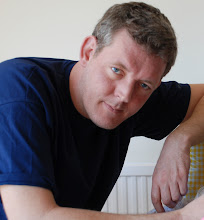 Here's a summary of the results from our testing of two Mscapes at Riverside Park, St.Pauls. A lot was learnt from simply watching the way in which they navigated the Scapes. Gratifyingly, since we'd worked hard to achieve this, our testers were persuaded to leave the surfaced footpaths in search of other experiences. As far as I could see, and speaking to the testers later, they all became quite engrossed in the Scape and were happy to devote time to it. All in all, a very positive reponse.
Here's a summary of the results from our testing of two Mscapes at Riverside Park, St.Pauls. A lot was learnt from simply watching the way in which they navigated the Scapes. Gratifyingly, since we'd worked hard to achieve this, our testers were persuaded to leave the surfaced footpaths in search of other experiences. As far as I could see, and speaking to the testers later, they all became quite engrossed in the Scape and were happy to devote time to it. All in all, a very positive reponse. We also asked our testers to complete a questionaire. here's a summary of their feedback:
QUESTIONAIRE:
1. What was the first thing you did?
The answers to this weren’t especially illuminating: ranging from ‘I walked around the park’ to just ‘I walked’, though one respondent headed for the river, prompted by music that sounded like a river.
2. How did you negotiate the virtual Scape?
There were two strategies at work here: one approach was to cover as much ground as possible, making sweeps of the park so as not to miss anything. The other was to follow the paths; but these respondents were both prompted by areas of silence (interestingly) to stray off the path in search of more.
3. The landscape is physical, the music/poemscape virtual –how did this feel?
 Since we’d been working hard to tie the MediaScape to the landscape (having found in our own experiments that this seemed to be crucial), the results are very pleasing:
Since we’d been working hard to tie the MediaScape to the landscape (having found in our own experiments that this seemed to be crucial), the results are very pleasing:‘It felt like it tied together. Prominent parts like the bridge were prominent in the soundscape’
‘It fits perfectly’
‘They felt fused –you...explore a double dimension blended in one single. In fact, they both became physical’
‘It felt like the ground is haunted and you’re wondering through the ghosts domian’ –again, it’s fixed to the ground/landscape.4. Content: Please comment on the music, on the words and on the music/word fusion. Was there a ‘narrative’?
Most of the answers concentrated on the issue of narrative: with opinions ranging from ‘I got a simple sense of narrative’, through ‘more of an “atmosphere” than a narrative’ to ‘didn’t figure much narrative’. The impression I got from the written responses (and speaking to the testers on the day) was that traditional narrative sense didn’t matter for them. They were happy to enjoy the experience on its own terms: ‘I liked how the lists of words ended-up sounding like music’.
5. Were you aware of the technology? (‘suspension of disbelief’, ‘immersive’?)
All agreed that it was a ‘totally immersive’ experience, with just one respondent reporting that the ‘spell’ was broken only by areas of silence which took them ‘out of the “place”’.
6. Was there any point at which the technology failed, or was confusing, or frustrating?
No problems reported except that two respondents said they mistook areas of silence for a technical failure, until they moved-on and realised that wasn’t the case.
7. Would visual aids (e.g. a map of the virtual layout) have made it easier/better to negotiate?
Opinions were split equally on this one: two resounding ‘No’s on the grounds that it would detract from the immersive quality of the experience; and two ‘yes’s, but primarily because they wanted to be sure they didn’t miss anything –and, even then, one of these respondents acknowledged that it may become less immersive with a map to hand.
(Just one ‘other comments’: ‘A lovely, atmospheric experience, I loved the poems and sounds’)
MAPS
 We also asked the testers to draw/write/or doodle their experiences of the MediaScapes onto pre-prepared outline maps of the area. These were completed for the two versions of MediaScape (Phill's and Ralph's) for Riverside Park, St.Pauls. What I find extraordinary is that most of the maps were so full and corresponded so accurately to the MediaScapes. Clearly, the Scapes succeeded in producing disinctive areas, with clearly discernable moods and themes, producing coherent experiences that the testers were able to represent and annotate on a physical map. Compare, for example, Ralph's Mediascape with a sample map from the testers:
We also asked the testers to draw/write/or doodle their experiences of the MediaScapes onto pre-prepared outline maps of the area. These were completed for the two versions of MediaScape (Phill's and Ralph's) for Riverside Park, St.Pauls. What I find extraordinary is that most of the maps were so full and corresponded so accurately to the MediaScapes. Clearly, the Scapes succeeded in producing disinctive areas, with clearly discernable moods and themes, producing coherent experiences that the testers were able to represent and annotate on a physical map. Compare, for example, Ralph's Mediascape with a sample map from the testers:(click on the images to see a larger view)
Here's Phill's Scape too, again next to a testers map, for comparison:
Some of our testers got completely carried-away with their colouring crayons!:
I read the smileys and hearts as positive feedback!
I think the maps experiment worked really well, giving much more of a feel for the way in which people responded to the experience than would verbal or written reports. I'll be using this again.
All in all, very positive and also very useful feedback. Thanks once again to our testers.







